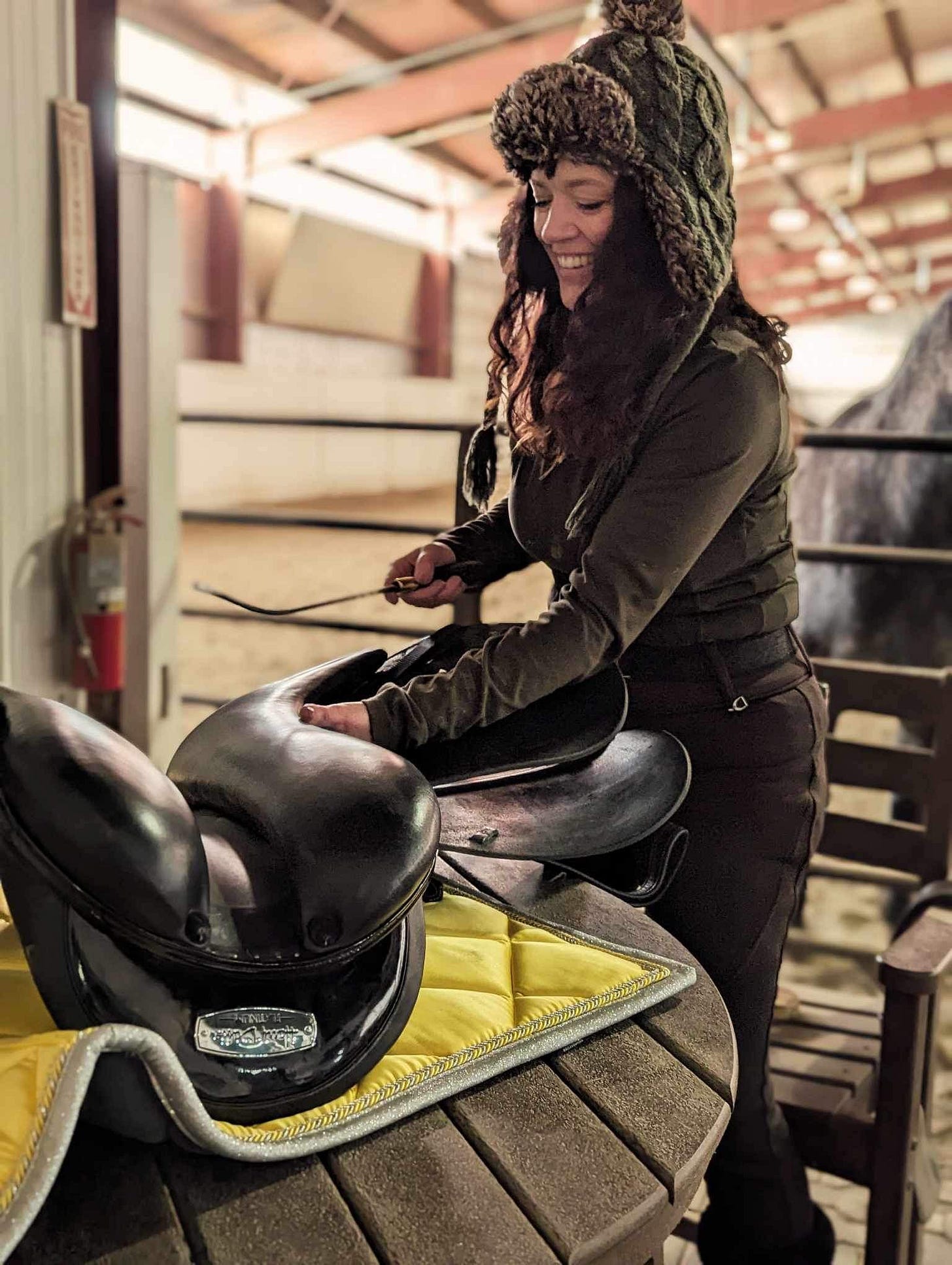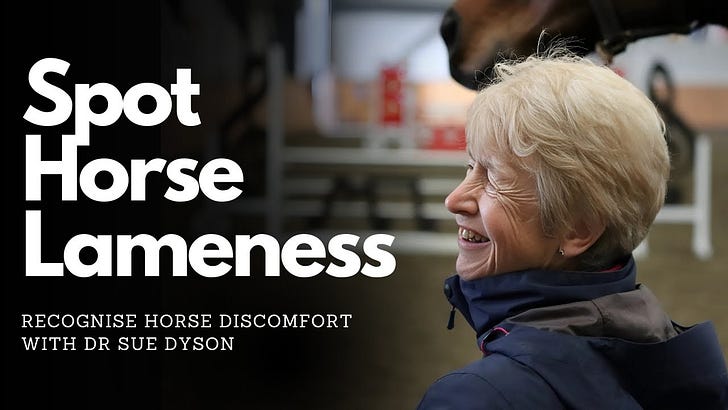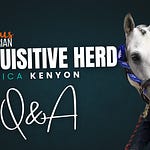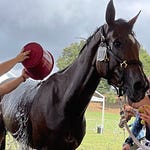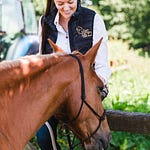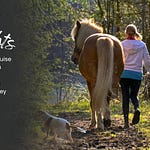We meticulously schedule our horses' farrier visits, dental check-ups and vaccinations, there's one crucial aspect of equine welfare that remains woefully overlooked: saddle fitting. This week's conversation with certified saddle fitter Jennifer Howland-Christensen reveals the startling truth about how badly fitted tack is silently damaging our horses – and why the solutions are more accessible than we think.
This Week's Deep Dive 🎧
Guest: Jennifer Howland-Christensen, Certified Saddle Fitter and Owner of High Plains Saddle Fitting
Background: Former hairstylist turned equine professional, working with her challenging Appaloosa, Zippy
Key Topics:
The physical and psychological damage caused by ill-fitting saddles
Early warning signs every horse owner should recognise
The ancient craft of wool flocking and why it matters
Common mistakes in the hunter-jumper world
The Big Takeaway
Your horse's behaviour problems might actually be pain responses in disguise. Jennifer's own journey with her expressive Appaloosa, Zippy, taught her that what trainers often label as "naughty" behaviour – head bobbing, resistance after jumps, girthiness – can actually be horses crying out in discomfort. When Jennifer discovered Zippy had severe ring bone, suddenly his "sass" after landing jumps made perfect sense: he was experiencing pain on impact.
This revelation extends far beyond individual horses. We're perpetuating a cycle where generations of riders are taught to place saddles too far forward, to "pad up" narrow saddles, and to prioritise appearance over comfort. The result? Horses developing muscle atrophy, movement dysfunction, and lasting physical damage that could be entirely preventable.
Three Things That Stood Out
1. "I can walk up to a horse and see where the tree point is digging in"
Jennifer's ability to visually identify saddle pressure points speaks to how common this problem has become. She regularly encounters horses with visible indentations in their muscles where poorly fitted saddles have created lasting damage. The most telling sign? That hollow space behind a horse's withers – an indicator that the trapezius muscle has suffered from sustained pressure and poor saddle placement.
2. The six-to-nine-month rule that most owners ignore
Unlike other equine services, saddle fitting isn't a "set it and forget it" arrangement. Wool settles, horses' bodies change, and what fitted perfectly in spring may be causing problems by autumn. Jennifer trains her clients to check wither clearance while mounted, a simple test that can prevent weeks of discomfort for their horses.
3. "We're judging on aesthetics rather than what actually fits"
Perhaps the most damning observation about modern equestrian culture: in hunter classes, riders lose points for non-traditional tack choices, regardless of how well they fit their horses. This creates a perverse incentive system where appearance trumps animal welfare, something Jennifer believes needs urgent reform.
Deep Dive Analysis
The Physical Consequences: More Than Just Discomfort
The mechanics of saddle fitting reveal why this issue demands urgent attention. When a saddle doesn't fit properly, whether too narrow or too wide, it creates uneven pressure distribution across the horse's back. This pressure doesn't just cause momentary discomfort; it fundamentally alters how horses move.
A horse experiencing saddle pain will hollow its back to evade discomfort, creating a cascade of biomechanical problems. This defensive posture prevents proper engagement of the hindquarters, affects shoulder movement, and can eventually cause the horse's chest to drop away from the shoulder girdle. The result is a horse that cannot move efficiently, leading to accelerated breakdown and shortened athletic careers.
Jennifer's description of permanently grooved backs, literal indentations where ill-fitting saddles have caused muscle wastage, serves as a stark reminder that these aren't temporary issues. The damage can be irreversible.
The Education Gap: When Tradition Trumps Science
The saddle fitting industry faces a unique challenge: in many regions, particularly rural areas of the United States, the service is still considered novel. Jennifer frequently encounters horse owners who've never worked with a saddle fitter, requiring extensive education about why regular checks matter.
This education gap perpetuates dangerous practices. The common belief that horses need "medium trees" oversimplifies a complex biomechanical puzzle. Tree shape, angle, and balance all play crucial roles in saddle fit, yet many riders make purchasing decisions based on oversimplified categorisations.
The Art Meets Science: Why Wool Flocking Endures
In an age of synthetic materials and foam padding, wool flocking represents a 14th-century technology that remains unmatched for customisation and performance. The natural material's ability to conform to individual horse shapes, combined with its moisture-wicking and shock-absorbing properties, explains why skilled fitters still prefer this labour-intensive approach.
Jennifer's description of the flocking process, carefully layering Jacob's wool to create precise pressure distribution, illustrates why saddle fitting combines technical knowledge with artisanal skill. The satisfaction she describes in achieving the perfect fit reflects the deep craftsmanship involved in this ancient trade.
Questions for Reflection
When did you last have your saddle professionally assessed? Consider whether you're treating saddle fitting with the same regularity as other essential equine services, or if it's something you've been putting off.
How might your horse's "difficult" behaviours actually be communication? Think about moments when your horse shows resistance or attitude, could these be pain responses rather than training issues?
Are you making tack choices based on tradition and appearance, or on what's best for your individual horse? Reflect on whether show ring conventions or yard expectations influence your equipment decisions more than your horse's comfort.
What's Coming Up
Member Q&A: This Friday's exclusive content features Jennifer answering subscriber questions about specific saddle fitting challenges, from dealing with horses who've developed tack anxiety to navigating the tricky transition period when young horses are still changing shape.
Join the Conversation
What surprised you most about Jennifer's insights into saddle fitting? Have you noticed warning signs in your own horse that might indicate tack issues? Share your experiences in the comments below; your observations could help other horse owners recognise problems before they become serious.
[For free subscribers reading this Thursday]: Want early access to these deep dives plus exclusive member Q&As with our guests? Join as a paid subscriber for detailed follow-ups, practical worksheets, and priority access to expert advice that could transform your horse's wellbeing.
Remember: your horse can't tell you in words when something hurts, but they're constantly communicating through their behaviour and body language. Learning to listen might be the most valuable skill we can develop as horse owners.
Need help identify pain and discomfort in horses watch our previous episode with Dr Sue Dyson.
Horse Lameness: A Revolutionary Approach to Detecting Pain in Horses
Have you turned to your fellow horse owners in the yard and uttered, "Does my horse look right?" or "Does my horse look lame"? I certainly have or had others say things like, "He looks a bit footy," I nod along, not wanting to admit that I don't know the subtle signs of lameness. Well, no more. Dr Sue Dyson is changing all that.



